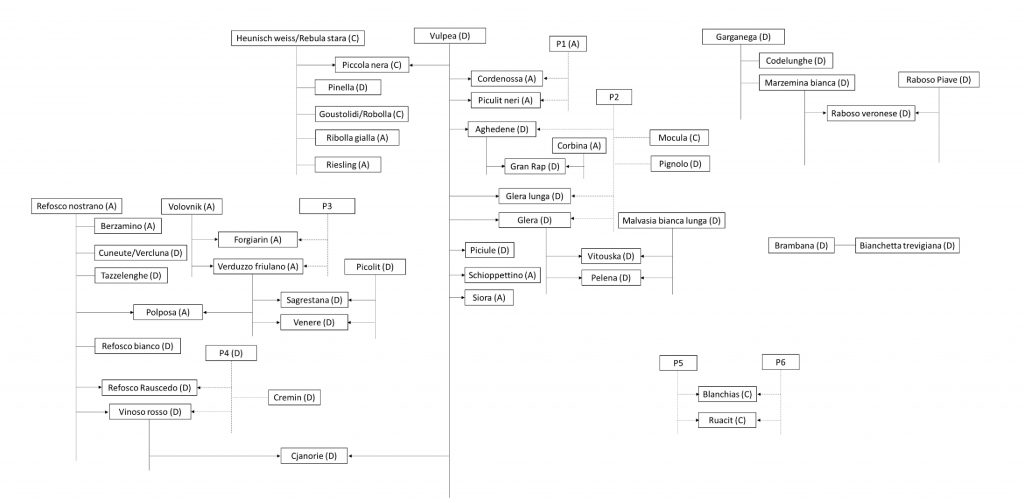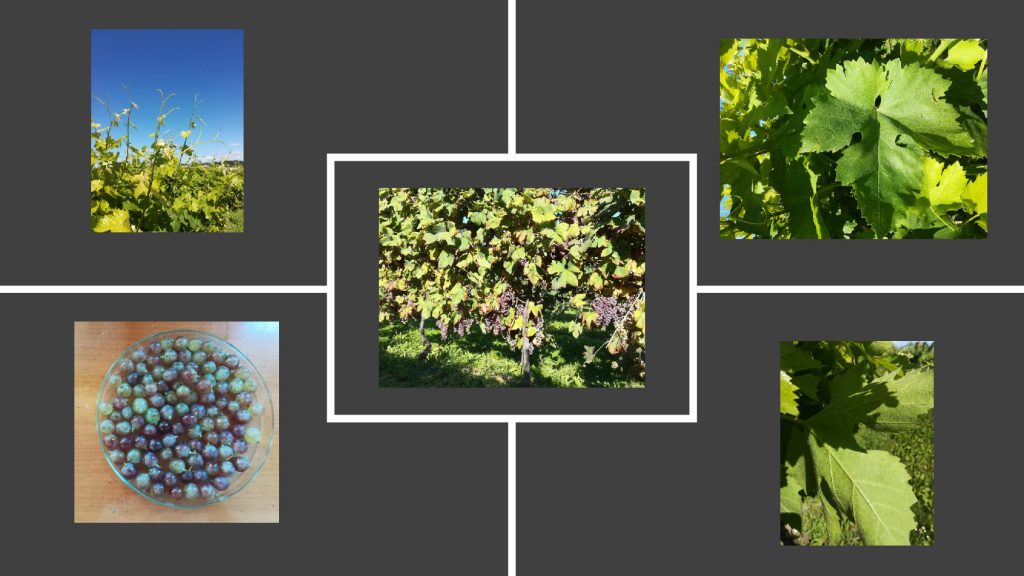By Manna Crespan
‘Glera’ and ‘Ribolla gialla’ are the most economically relevant local grapevine cultivars of Friuli Venezia Giulia (FVG) region (north-eastern Italy). ‘Glera’ is used to produce the world-renowned Prosecco wine, while there is an increasing interest in ‘Ribolla gialla’ cultivation due to the strong demand for sparkling wine. Moreover, ‘Ribolla gialla’ is the most important variety in Brda area (Slovenia), on the border with FVG.
Prospections, genotyping and ampelographic characterization of minor germplasm in FVG were carried out from 2001 to 2008 by ERSA (Agenzia Regionale per lo Sviluppo Rurale of FVG) technicians and experts in collaboration with the CREA – Research center for viticulture and enology of Conegliano (Treviso, Italy). Information on these varieties is available in the Italian Vitis Database (IVD) web site (https://vitisdb.it). A further research was developed to understand the parentage relationships among the grapevine varieties grown in this region. To this aim, an integrated approach was used combining the analysis of nuclear and chloroplast microsatellite (SSR) markers with Single Nucleotide Polymorphism (SNP) markers, using the Vitis 18k SNP chip of ILLUMINA. This last analysis involved several thousand points of the genome, obtaining a very solid data support.
As a result, two main recurrent parents were found, which can be regarded as “founders” of many others (Fig. 1). One is ‘Refosco nostrano’ or ‘Refoscone’, the main representative of the local Refosco’s family; it is parent-offspring (PO) related with ‘Berzamino’ (IVD-var_27), ‘Tazzelenghe’ and the recently rediscovered ‘Refosco bianco’ (IVD-var_250); others PO-related varieties are ‘Cuneute’ alias ‘Vercluna’ (IVD-var_70), ‘Polposa’ (IVD-var_245), and ‘Vinoso Rosso’ (IVD-var_269).

The second founder was a totally unexpected variety, ‘Vulpea’. ‘Vulpea’ is the Romanian name of a variety that in the 19th century existed in nearly every Austrian and northeast Slovenian vineyard and in Siebenbürgen/Romania. The Austrian Helbling provided the first accurate description in 1777 under the name ‘Schwarzer Abendroth’. According to ampelographers of the 18th and 19th centuries the late maturating ‘Vulpea’ produced bunches with green, red and blue berries (Fig. 2). The wine was of low quality, had a light red color and sour taste, however the cultivar was appreciated for its heavy crop. ‘Vulpea’ was present also in FVG; some vines were recently found as anonymous plants or misnomered for ‘Codelunghe’ (IVD-var_232) and ‘Piccola nera’. ‘Vulpea’ was grown also in the nearby Veneto: as ‘Rossetta’ alias ‘Sciavetta’ alias ‘Doretta’ in the area of Euganean Hills (Padova), and as ‘Quaiara’ in Verona province; a popular rosé table wine was locally produced with its grapes.

Numerous FVG varieties with white or black grapes showed to be PO-related with ‘Vulpea’, among the best known and most renowned is ‘Glera’, then ‘Cordenossa’, ‘Glera lunga’, ‘Piccola nera’, ‘Piculit neri’ and ‘Schioppettino’, but also ‘Aghedene’ (IVD-var_13), ‘Piciule’ (IVD-var_243 ) and ‘Siora’ (IVD-var_260).
The pedigree reconstruction identified or confirmed a couple of descendants of ‘Glera’ from spontaneous crossings with ‘Malvasia bianca lunga’, they are ‘Vitouska’ (enrolled in the Italian Catalogue* in 1990) and ‘Pelena’.
‘Codelunghe’ (IVD-var_232) resulted to be PO-related with ‘Garganega’, another founder of many other varieties, from north to south of the Italian peninsula; to mention a couple of the best known, ‘Trebbiano toscano’ (alias ‘Ugni blanc’) and the Sicilian ‘Catarratto’.
The connecting bridge between the Refosco’s group and ‘Vulpea’ is the black ‘Cjanorie’ (IVD-var_58), offspring of ‘Vulpea’ and ‘Vinoso rosso’.
‘Volovnik’, a Slovenian variety, originated ‘Forgiarin’ (IVD-var_87) and the well-known ‘Verduzzo friulano’, probably thanks to a common complementary parent. ‘Verduzzo friulano’, in turn, crossing with ‘Refosco nostrano’ generated ‘Polposa’ (IVD-var_245) and, with ‘Picolit’, ‘Sagrestana’ (enrolled in the Italian Catalogue in 2014) and ‘Venere’ (IVD-var_264).
Another highlight of this research was discovering that ‘Ribolla gialla’ (‘Ribuele’ in the Italian Catalogue), grown in both Italian and Slovenian Collio (Brda), is one of the many varieties PO-related with the prolific ‘Gouais blanc’ alias ‘Heunisch weiss’. There is a lot to tell about this latter variety. It has dozens of offspring throughout the European continent, reflecting its widespread use in the past, followed by a significant reduction, given the superiority of its descendants, like ‘Chardonnay’ and ‘Gamay’ in France, and ‘Riesling weiss’ in Germany. ‘Gouais blanc’ has a myriad of synonyms (look at the VIVC**), among them, very interesting, is ‘Rebula stara’ (i.e. old Ribolla) in Slovenia. Moreover, ‘Piccola nera’ showed to be a cross between ‘Gouais blanc’ and ‘Vulpea’.
This study evidenced that ‘Refosco dal peduncolo rosso’ is not a progeny of ‘Marzemino’ and that ‘Marzemino’, in turn, is not PO-related to ‘Teroldego’. Present molecular data allow us to hypothesize that ‘Marzemino’ and ‘Refosco dal peduncolo rosso’ could be siblings. Similarly, ‘Glera’, ‘Glera lunga’ and ‘Aghedene’ could share also the second parent, who has yet to be identified; this mysterious vine could also have originated ‘Pignolo’ and ‘Mocula’ (IVD-var_137). Finally, ‘Brambana’ (IVD-var_41) and ‘Bianchetta trevigiana’ showed to be PO-related, while ‘Blanchias’ (IVD-var_32) and ‘Ruacit’ could be another pair of siblings.
Knowledge of local varieties history in terms of migration and pedigree relationships has scientific and marketing appeal. The puzzle of FVG grapevine varieties pedigree started to be reconstructed.
*Registro Nazionale delle varietà di vite (RNVV), http://catalogoviti.politicheagricole.it
**Vitis International Variety Catalogue (VIVC), http://www.vivc.de
This is an excerpt from the paper published on Scientific Reports journal (2020) 10:7206 | https://doi.org/10.1038/s41598-020-64061-w

Manna Crespan is a researcher working at CREA – Research Centre for viticulture and enology of Conegliano (Treviso, Italy) since 1996 on agricultural genetics. She is expert in characterization and identification of grapevine varieties using molecular markers and collaborates with Universities and research Institutes at national and international level. She organized and started the first molecular database at her Centre, encompassing the molecular profiles of thousands Vitis spp varieties, mostly wine but also table grapes, rootstocks, hybrids and pure species. She has carried out dozens of studies to get information on the history, connections, evolution, spreading, migration and pedigree relationships of grapevine varieties in and outside Italy. She contributed to develop knowledge on the evolution of grapevines also through the identification of somatic variants and searching for the genetic basis of intravarietal variability. She is the author and present responsible of SIV, the Service for Identification of grapevine Varieties at CREA. She authored/co-authored dozens of papers published on scientific international journals.

